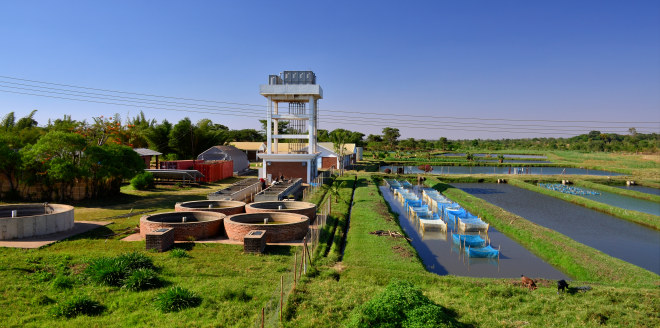Solar powered tilapia hatchery, Malawi

Introduction
Traditionally, Malawi is a fish-eating nation. However, what is left
on the table is mainly maize mush, traditionally called Nsima.
Although Malawi is blessed with the ninth largest lake in the world
and the third largest and second deepest lake in Africa, overfishing
resulted in the collapse of the tilapia fishery in the lake since
the beginning of the 90th. Tilapia-like species, specifically
Oreochromis karongae, known locally as chambo, are the country’s favourite fish. Owing to the Chambo scarcity on the market, its
wholesale price has risen from 2.5 Malawian kwacha (MK) per kilo in
the early 1990s to 130 MK per kilo in 2002. Today, the price has
reached recently more than 3000 – 6000 MK (corresponding to about
US$ 4.00-8.00) per kilo which is hardly affordable to the most
Malawian people. The historical yields of 70% of
Chambo in the nets has turned into only 3–5% Chambo today, with
small fish called Usipa (Lake Malawi
 sardine, Engraulicypris
sardella) being the most prominent fish in the catches from Lake
Malawi providing at present 70% of the yield.
sardine, Engraulicypris
sardella) being the most prominent fish in the catches from Lake
Malawi providing at present 70% of the yield.
Under these circumstances, aquaculture is being considered as one of the measures to provide more Chambo on the table and for the market, however, the production in the country is still small and in general not efficient. Aquaculture has a tradition of about 100 years in Malawi, introduced while England was ruling Malawi, taking off with about 60 ponds in the 1950s and is represented today with about 6000 active fish farmers. At present, about 3600t of tilapia-like species are being annually produced from the rural farmer. One of the major bottlenecks for smallholder farmers to improve their yield is the scarcity and unreliable of sufficient viable fingerlings, specifically from Chambo.
Thus, the "ICH LIEBE FISCH" project has established a specialized solar powered hatchery and optimized rearing protocols, in order to improve the sustainable supply of fingerlings for ongrowing farms of a high valued endemic fish species in combination with the introduction of aquaponics and integrated agriculture-aquaculture production methods.
The following information provides details on the operation of the solar powered hatchery at he farm of the Bunda Campus, which is part of the University of Lilongwe (LUANAR) with the department of fisheries and aquaculture.
Fingerling production remains a very important factor in fish farming for it determines the quality and quantity of fish a farmer will harvest in the end. However, availability and accessibility of good quality fingerling in required quantities remain a big challenge for Malawian fish farmers. This is caused due to a number of factors some of which arise due to lack of proper hatchery management expertise as well as lack of understanding of the biological and physical factors optimal for fingerling production.
Propagation and production of fingerlings is usually conducted in ponds with all generations of tilapia. This implies, however, an unfavorable environment for fingerling production, including predation (predatory tadpoles from frogs are a huge problem in open ponds), cannibalism, feed competition and environmental impact. Thus, the number of offsprings which can be expected from the farmer in a breeding season is unknown.
Innovative hatchery technology
for Malawi
Thus, one of the major goals of
the project ¨Ich liebe Fisch "was to establish technologies which
improve significantly the stable supply of viable fingerlings to
farmers which want to grow fish for food and for the market. To
achieve this goal, the project has provided a solar powered indoor
hatchery which is designed to support intensive production of
tilapia fingerlings, specifically from Chambo.

The picture shows part of the environment of the Bunda Campus farm where the tilapia hatchery is located. The farm has broodstocks of various tilapia species, such as Oreochromis karongae, O. shiranus, C. rendalli and O mossambicus.